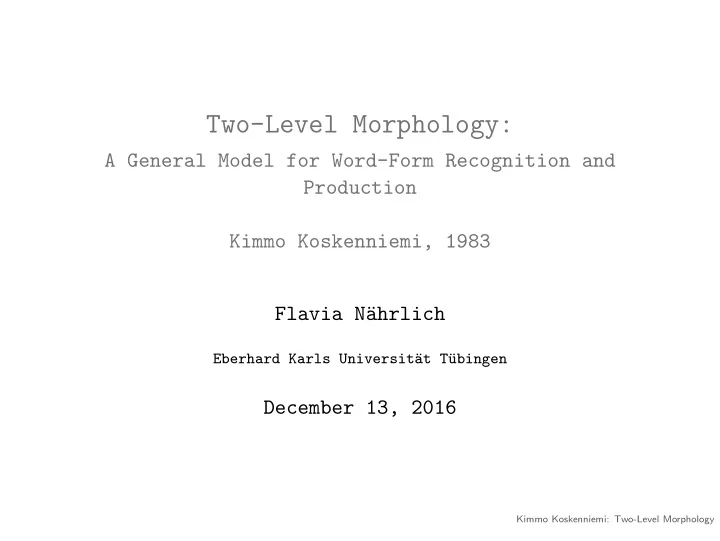

Two-Level Morphology: A General Model for Word-Form Recognition and Production Kimmo Koskenniemi, 1983 Flavia N¨ ahrlich Eberhard Karls Universit¨ at T¨ ubingen December 13, 2016 Kimmo Koskenniemi: Two-Level Morphology
Content 1. Previous Work on Computational Morphology 2. The Two-Level Approach 3. Properties and Goals of Two-Level Morphology 4. The Lexical Representation 5. Two-Level Rules 6. Lexical Transducers 7. A Critical View on Two-Level Morphology Kimmo Koskenniemi: Two-Level Morphology
1. Previous Work on Computational Morphology 1.1. Generative Phonology 1.2. More General Approaches for Morphological Analysis 1.3. The Model of Kaplan and Kay Kimmo Koskenniemi: Two-Level Morphology
1.1. Generative Phonology • traditional phonological grammars formalized by Chomsky and Halle, 1968 • computationally difficult • set of ordered rewriting rules • step by step transformation • unidirectional • not parallel • problem of rule interaction Kimmo Koskenniemi: Two-Level Morphology
1.2. More General Approaches for Morphological Analysis • in English systems usually very few true morphological rules, simply listed in the lexicon • entirely language specific morphological systems • formalismus not general enough to handle e.g. finnish morphology (phenomena like consonant gradation) • TEXTFIN for Finnish morphological analysis (Karttunen 1981) relies on concept of linked minilexicons • complexity of Finnish morphology is not beyond the power of regular grammars or finite state automata Kimmo Koskenniemi: Two-Level Morphology
1.3. The Model of Kaplan and Kay, 1982 • representing rewriting rules as finite state automaton • successive levels of the generative framework • cascades of rule transducers could be merged into single automaton • problem: size of the merged automaton Kimmo Koskenniemi: Two-Level Morphology
2. The Two-Level Approach • follows the lines of concrete and natural morphology • role of rules is restricted to one-segment variations • alternations wich affect more than one segment are handled by a lexicon system • no intermediate stages Kimmo Koskenniemi: Two-Level Morphology
3. Properties and Goals of Two-Level Morphology • language independent • parallel and relatively independent rules • bidirectional (conceptually and processually) • single rules as finite state automaton • realistic internal representations • minimal complexity, small finite state automata • operational computer program • computational efficent analysis and generation of morphologically complex languages Kimmo Koskenniemi: Two-Level Morphology
4. Two-Level Rules • only lexicon and phonemic surface representations • lexicon: representations of word entries and endings, e.g. Finnish • phonemic surface level: phonemes, or letters of phonemic alphabet • parallel rules refer to both representations • production or analysis by separate mechanism guided by the rules Kimmo Koskenniemi: Two-Level Morphology
4. Two-Level Rules • partitive plural of lasi ("glass") • specify how lexical and surface rules may correspond to each other • regard individual rules as equations • stem final i is realized as e in front of typical plural forms, e.g. the plural morpheme I • I is realized as j if it is between vowels • partitive ending A agrees with the stem with respect to vowel harmony, i.e. the harmonic value of the Kimmo Koskenniemi: Two-Level Morphology system
4. Two-Level Rules two-level rules resemble generative rewriting rules Kimmo Koskenniemi: Two-Level Morphology
4. Two-Level Rules =-= denotes "any other pair" permit the pair i − e if and only if the plural I follows Kimmo Koskenniemi: Two-Level Morphology
4. Two-Level Rules Kimmo Koskenniemi: Two-Level Morphology
4. Two-Level Rules • each rule of a two-level description corresponds to finite state automaton • rule-automata compare two representations • automata work in parallel instead of being cascaded • rules can be written as tabular automata Kimmo Koskenniemi: Two-Level Morphology
5. Lexical Transducers • set of two-level transducers compiled from phonological rewrite rules can be merged into a single one • size of resulting single transducer is huge compared to the size of the original rule network • worst case: exponetial Kimmo Koskenniemi: Two-Level Morphology
5. Lexical Transducers • intersection of two-level rules is huge because it constraints realization of all strings in universal language • typically only strings of particular language are interesting • by composing lexicon with the rules spurious strings can be filtered out • composing a source lexicon with an intersected two-level rule system is never sgnificantly larger than original source lexicon • typically much smaller than intersection of the rules by themselves Kimmo Koskenniemi: Two-Level Morphology
5. Lexical Transducers • intersecting and composing two-level rules with a lexicon results in single lexical transducer • contains all lexical forms of the source lexicon and proper surface realisations as determined by the rules Kimmo Koskenniemi: Two-Level Morphology
6. A Critical View on Two-Level Morphology 6.1. Tasks and Limitations 6.2. Bartons Challenge Relating to Complexity Kimmo Koskenniemi: Two-Level Morphology
6.1. Tasks and Limitations • in the implementation of 1983 all two level rules are compiled into finite state automata by hand • a compiler wich accepts rules directly in two-level formalisms could automatically transform the rules into finite state automata • two-level constraints are inviolable • in Optimality Theory some problems of two-level morphology can be solved by using vioable rules • a finite-state formalism with weighted and vioable two-level constraints would be desireable Kimmo Koskenniemi: Two-Level Morphology
6.2 Bartons Challenge Relating to Complexity • two-level morphology has been found an extremely efficient method for processing Finnish word on very small machines • Barton has shown the complexity of two-level method to be NP-hard • suggestion: words of natural languages are easy to analyze because morphological grammars are small • Barton has shown two-level complexity grows rapidly with the number of harmony processes • natural grammars do not have more than two harmony processes • generation time is linear with length of words and exponential with number of harmony processes • in practice processing time is linear with input legth Kimmo Koskenniemi: Two-Level Morphology
Recommend
More recommend